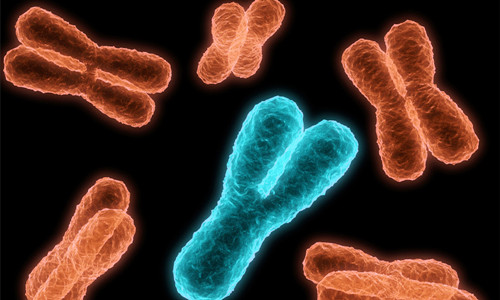CRISPR/Cas9 gene editing can be used to eliminate entire chromosomes — a Q&A
December 5, 2017
Source: biomedcentral
 940
940

Why is eliminating an entire sex chromosome something you’ve been working on?
As is well known, CRISPR/Cas9 is an effective tool for gene editing, and this method has been widely used for editing genes or genomic regions by targeting specific single-guide RNA (sgRNAs). We initially planned to use the CRISPR/Cas9 system to study the biological functions of Y chromosome genes. The Y chromosome is highly specialized for male sex differentiation and fertility. However, so far only a few genes have been assessed for biological function in targeted knockout mice. Therefore, besides Y chromosome single-copy genes, we also tested whether Y chromosome genes with multiple copies could be efficiently deleted. To our surprise, we found that deletion of multiple-copy genes, Ssty1, Ssty2 and Rbmy1a1, resulted in sex reversal of male embryos. Experimental data revealed that the sex reversal was caused by an entire Y chromosome deletion, rather than the knockout of the multiple-copy genes. Thus, an entire chromosome, including sex chromosome X and Y, as well as an autosome, could be deleted by multiple DNA cleavages on the specific chromosome, induced by a sgRNA that targets multiple chromosome-specific sites or a cocktail of multiple sgRNAs, each targeting one specific site.
How does your study build on previous research?
With the advent of CRISPR/Cas9, scientists have been trying to apply this technique to multiple fields, including gene deletion, gene insertion, large fragment deletion and chromosome translocation. However, whether an entire chromosome could be deleted via CRISPR/Cas9 is an intriguing question. Previous studies showed that targeted chromosome elimination could be achieved by insertion of oppositely oriented loxP sites into a targeted chromosome followed by Cre-mediated sister-chromatid recombination, or by insertion of a TKNEO transgene into one copy of targeted chromosome followed by drug selection of chromosome-deletion clones via spontaneous chromosome loss. Both of these approaches require two-step manipulation and have a low yield of obtaining chromosome-deleted cells, thus unsuitable for in vivo studies. By contrast, CRISPR/Cas9-mediated targeted chromosome elimination offers a new approach to develop animal models with chromosome deletions, and a potential therapeutic strategy for human aneuploidy diseases involving additional chromosomes.
What are the clinical implications of this technique? Could you highlight a few specific conditions that this could prevent in the future?
Aneuploidy is a human genetic disorder related to the addition or deletion of a chromosome, leading to significant morbidity and mortality during infancy or childhood, including Down’s syndrome (an extra 21), Klinefelter Syndrome (an extra X) or XYY syndrome. Using CRISPR/Cas9 – mediated targeted chromosome elimination, an extra chromosome could be selectively eliminated in cultured cells, embryos, and, more importantly, tissues in vivo, providing a potential therapeutic approach for aneuploidy diseases. However, when one of two homologous X chromosome was deleted by this approach, we found that the remaining X chromosome was also mutated. We believe these mutations in the remaining one (XXY and XYY syndrome) or two chromosomes (Down’s syndrome) could be avoided by using sgRNAs that target only one of the two or one of the three homologous chromosomes, based on single nucleotide polymorphism. Aneuploidy is also a hallmark of cancer. CRISPR/Cas9 – mediated targeted chromosome elimination offers a new approach for studying aneuploidy in tumorigenesis and a potential treatment strategy against a broad spectrum of human tumors.
Could you describe how you achieved the elimination of a whole chromosome, what were the main challenges?
CRISPR/Cas9 is like a molecular scissor, which can specifically cut designated positions in a DNA sequence through the guide of sgRNA. In essence, the chromosome is a series of very long DNA sequences, with repetitive sequences on it. These repetitive sequences come up at particular intervals. By designing sgRNAs targeting these repetitive sequences, CRISPR/Cas9 can break all the repeats in the chromosome. You can image that as a tie being cut hundreds of times, and the chromosome would be destroyed beyond the limits of cell repair. Therefore, the targeted chromosome cannot participate in the process of DNA replication during the cell division, and will disappear in the offspring.
The main challenge of this technique is how to induce multiple DNA cleavages efficiently. The efficiency of chromosome deletion varies among different repeat sequences and it is very hard to predict whether these repetitive sequences “work well”. The other challenge is how to selectively targeted one of two or three chromosomes.
What are the ethical implications of gene editing techniques like CRISPR?
As researchers in the field of gene-editing, we all believe that this technology will play an important role in therapeutic treatment. Meanwhile, we fully understand the ethical concerns of this technique in society today, so we always support and obey ethical guidelines regarding use in editing human germ cell, terrorism, threats to ecological security and other guidelines proposed by specialists in the international conference of stem cells, etc. There are many issues to be solved before using this technique to treat patients, such as targeting efficiency, delivery methods and off-target effects. All technologies require necessary rules to constrain, thus we will communicate with various circles of society to ensure the safety of people and the environment.
By DduRead more on
- Things to Know before Buying Newborn Baby Incubators March 31, 2022
- Could epigenome editing prevent developmental disorders? December 13, 2019
- If You Don’t Have This Gene, You May Recover Better from a Stroke March 15, 2019
- Highly Resistant Food Poisoning Bug Responds to Antibiotics September 6, 2018
- Smartphone Based Diagnosis to Identify Mosquitoes Transmitting Infection September 5, 2018
your submission has already been received.
OK
Subscribe
Please enter a valid Email address!
Submit
The most relevant industry news & insight will be sent to you every two weeks.



